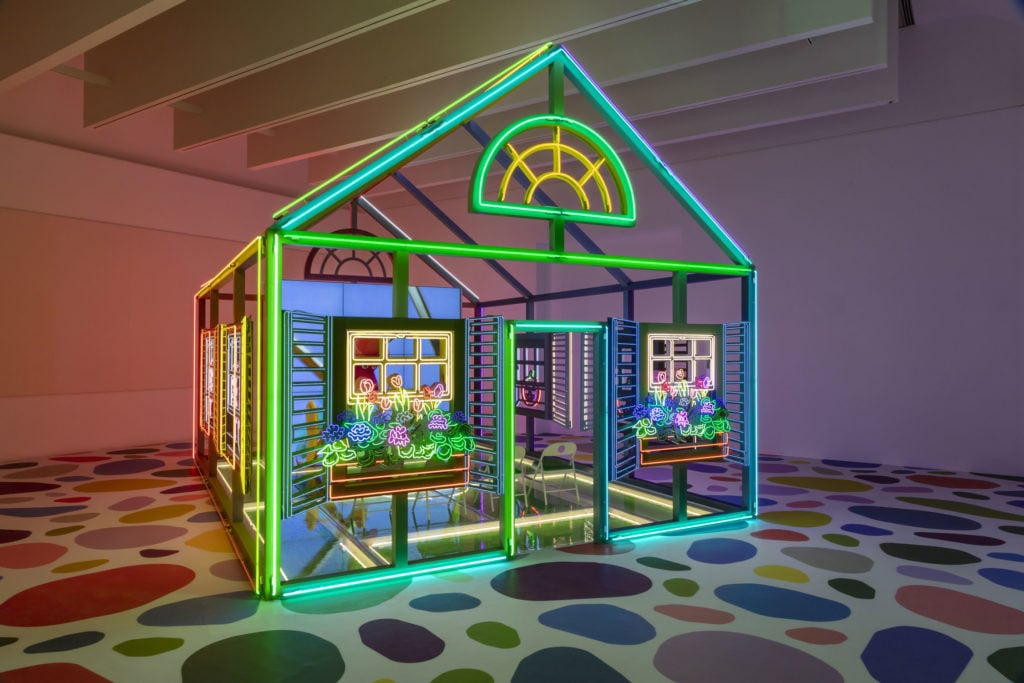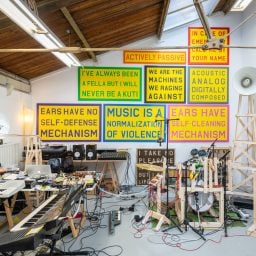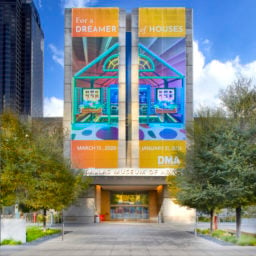The Carnegie International is the country’s oldest recurring survey, organized by Gilded Age magnate Andrew Carnegie in 1896 in the Pittsburgh museum he founded a year earlier. This year’s edition, the 57th—like the famous Heinz steak sauce, which also hails from the city—is particularly proud of this past.
Led by curator Ingrid Schaffner—a Pittsburgh native—one goal of this year’s show is what she calls “Museum Joy,” a phrase she’s coined to connote the delight of looking at art with others. Her show looks to celebrate the International’s own long history as a source of delight and epiphany for an audience—and many of the International’s 32 artists and collectives indeed do spend a lot of time finding ways to pay homage to that long and loaded past.
A small show-within-the-show organized by Cameroon-born, Senegal-based independent exhibition-maker Koyo Kouoh may be the part of the International that succeeds best this goal. Kouoh’s exhibition, “Dig Where You Stand,” features works of art, books, and various artifact’s that she sourced from the Carnegie’s own collection, as well as that of the adjoining Natural History Museum.
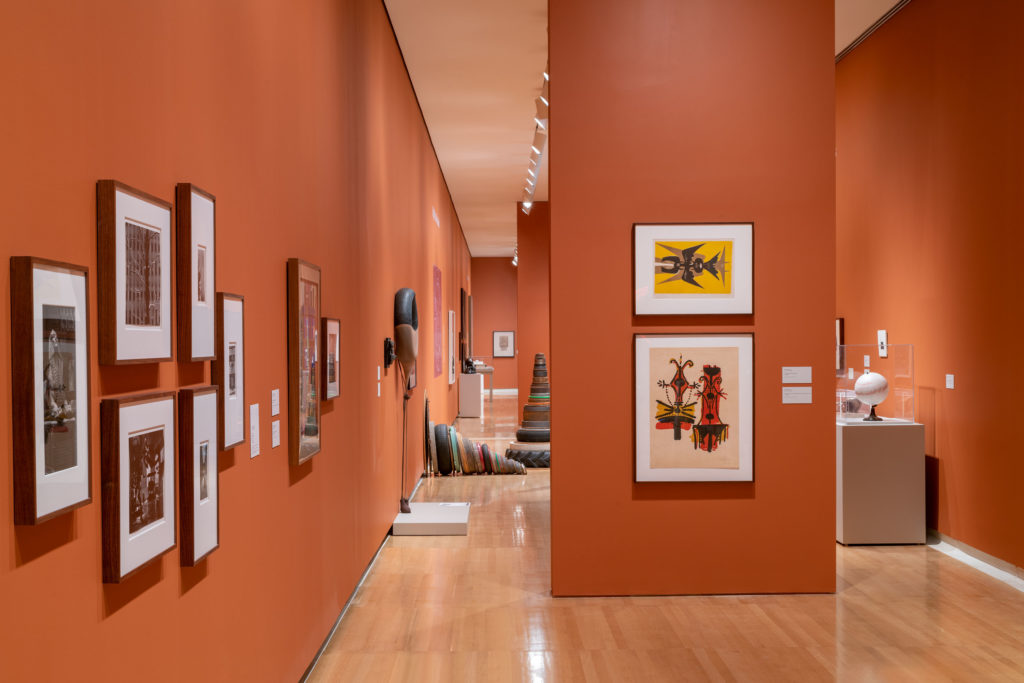
Installation view of Koyo Kouoh’s Dig Where You Stand, 2018. Courtesy of the artist and the Carnegie Museum of Art. Photo: Bryan Conley.
Installed not by chronology or canonized movement but by three other thematic “constellations” —“Coloniality and Agency,” “Speculative Temporalities,” and “Mobility and Exchange”—the mini-show, set within the museum’s long, narrow Scaife Galleries, reconsiders how labor, race, and other issues influence our perception of art history, especially within the context of an institution built on the bones of old American industrial wealth. Accompanied by a diagrammatic map that both lays out the physical installation and its thematic connections, the show positions seemingly disparate artists in conversation with one another.
For example, a glamorous Cecil Beaton photograph of Queen Elizabeth II is installed next to a Beauford Delaney painting of a Pittsburgh heiress and a taxidermied bald eagle shot down at the Battle of Gettysburg. These artifacts are connected by their respective depictions of symbolically powerful subjects, icons of power and agency.
Kouoh’s curatorial intervention is an imperfect experiment, but in an International so dead set on reminding us of the breadth of its own history, it’s the closest thing we get to a truly sharp critical engagement with the ways in which that history was actually built.
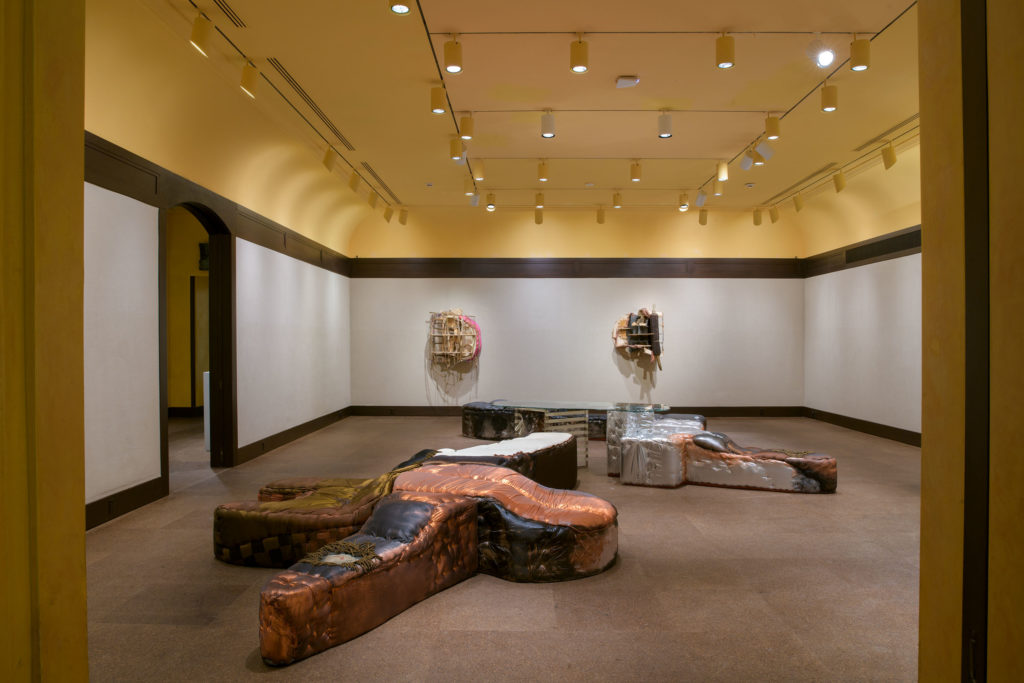
Installation view of Jessi Reaves’s Silver Pitfall, 2018. Courtesy of the artist; Bridget Donahue, New York; and Herald St., London.
As far as biennials go, the 57th International is a refreshingly manageable size. The whole of the show is contained within the museum itself, thereby resisting the urge to stage offsite shows throughout the hosting city.
There are no traditional wall labels; instead, just signs that correspond to entries in a small book—The Guide—that provides background texts on each of the artists, the “International,” and Schaffner’s own curatorial process. As a supplementary tool, it encourages an active, hands-on brand of engagement, though also a quiet, isolated one that stands at odds with “the commotion of being with art and other people actively engaged in the creative work of interpretation” that defines “Museum Joy.”
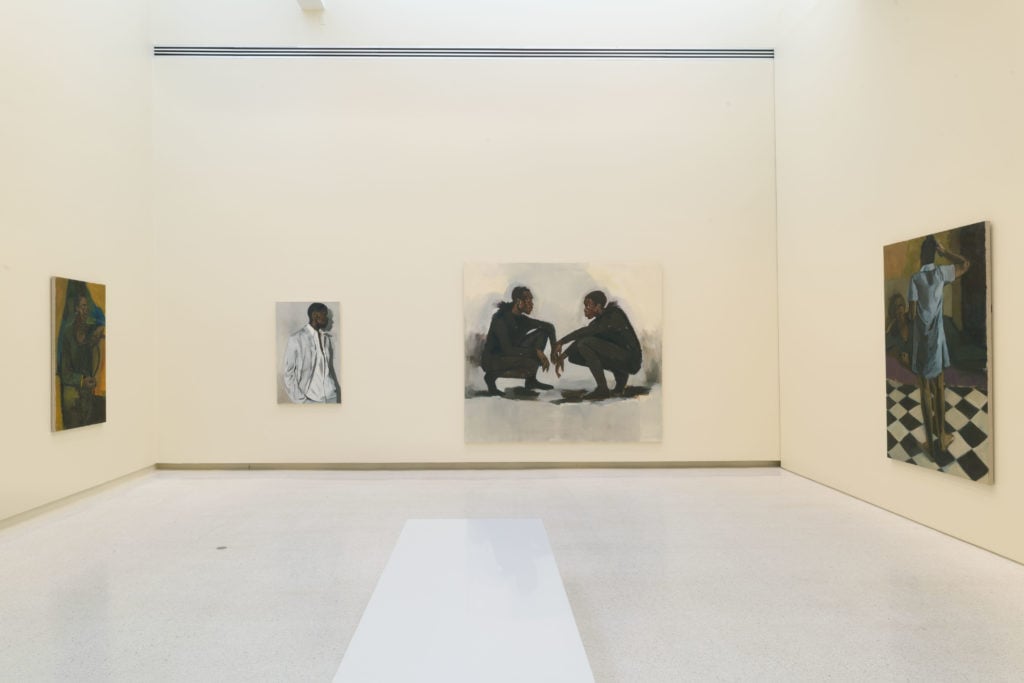
Installation view of paintings by Lynette Yiadom Boakye. Courtesy of the artist and the Carnegie Museum of Art. Photo: Bryan Conley.
That sociable kind of joy is more accessible with some projects more than others. Art Labor, a collective of artists from Ho Chi Minh City, turn a second-floor gallery into a Vietnamese café where you can drink coffee grown by the father of one of the group’s members; lay in a hammock; and look up at a series of kites painted to resemble a jungle (the latter are actually by famed US artist Joan Jonas, collaborating with Art Labor).
The project is a spiritual cousin to artist Rirkrit Tiravanija’s turn at the 1995 Carnegie International, in which he cooked and served Thai food to gallery-goers. This connection isn’t lost on the members of Art Labor, who worked as assistants to Tiravanija when he executed a project in Vietnam in the early 2000s—showing by example the paths by which international influence has spread from the International.
Nearby, South Korean filmmaker IM Heung-soon, in collaboration with writer Han Kang, contributes a new two-channel video. Interviews with victims of military dictatorships in Argentina in the late 1970s and South Korea in the ‘80s play on opposite screens.
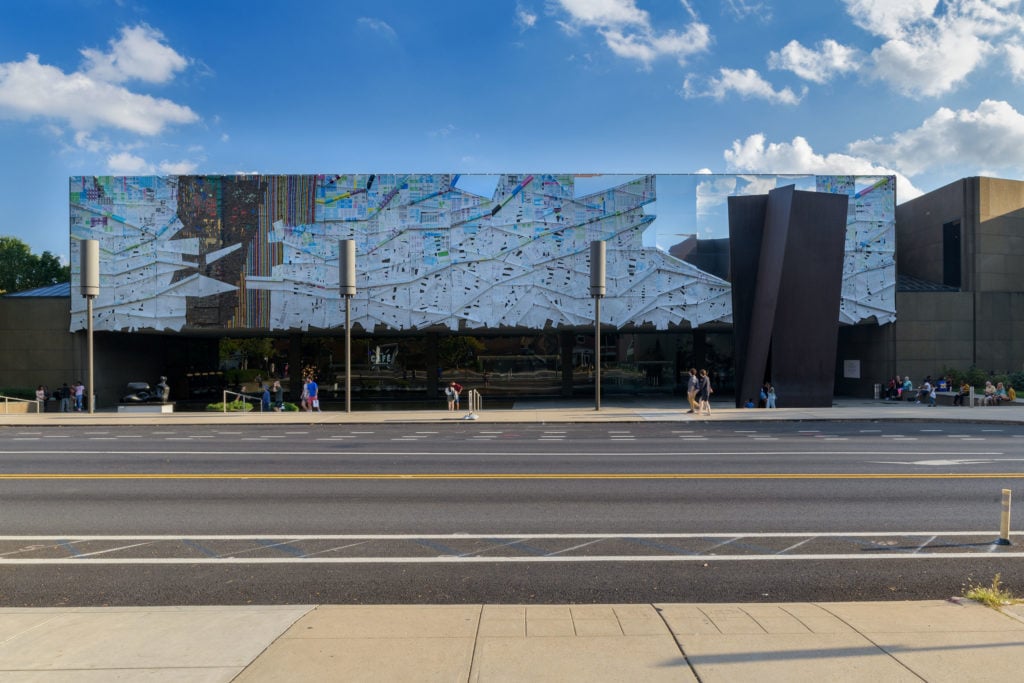
The Carnegie Museum of Art, covered in El Anatsui’s Three Angles (2018). Courtesy the artist and Jack Shainman Gallery. Photo: Bryan Conley.
International though the show aims to be, it is Pittsburgh that gets the spotlight more often than not. The 160-foot-long façade of the Edward Larrabee Barnes–designed building is wrapped in a sheeted piece from Ghanaian artist El Anatsui, made up mostly of discarded printing plates from a local press. Passing beneath this, you’ll see a row of wood sculptures by Pittsburgh-born artist Thaddeus Mosley upon entry.
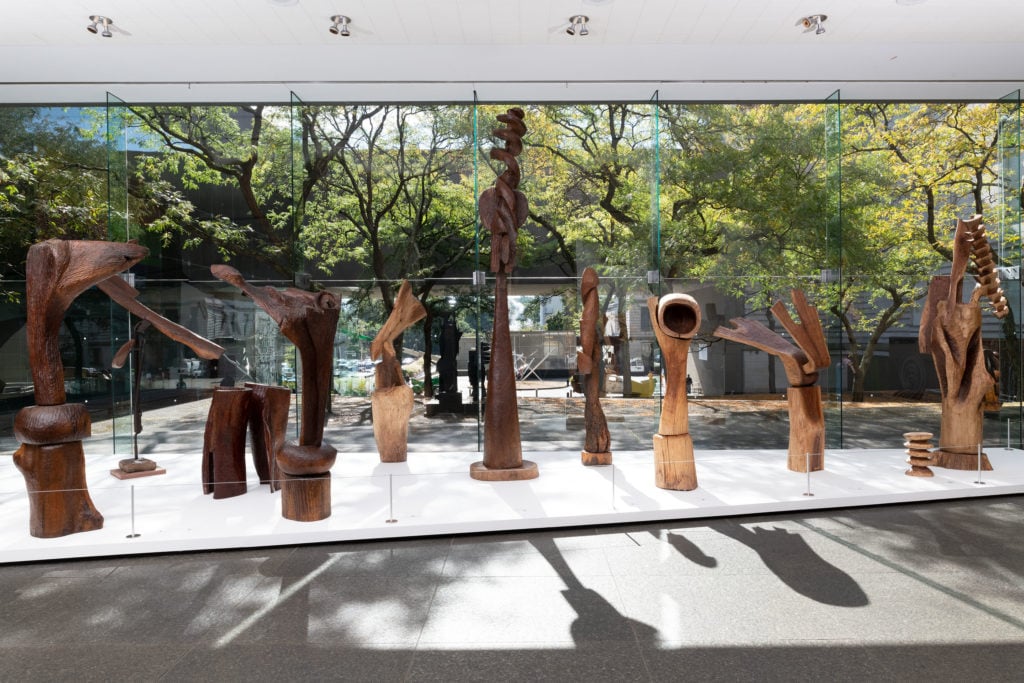
Installation view of Thaddeus Mosley’s sculptures. Courtesy of the artist and the Carnegie Museum of Art. Photo: Bryan Conley.
Opposite is the Carnegie’s lobby gallery, occupied with a work by local artists Lenka Clayton and Jon Rubin, who have hired calligraphers to paint the titles of works rejected by early, open call versions of the “International” on sheets of paper every day. While funny—word paintings with phrases like “A Fair Wind” or “A French Girl” line the walls—the jokey effect wears off quickly.
Other projects here are more abstract but still more successful. In the museum’s sky-lit hall of sculpture is a room-filling installation by artist collective Postcommodity. Jagged piles of coal, steel, and glass—remnants of Pittsburgh’s industrial past—are arranged in star-like shapes. The sculptural work is also conceived of as a musical score. The work is interpreted by a local jazz musician four times weekly.
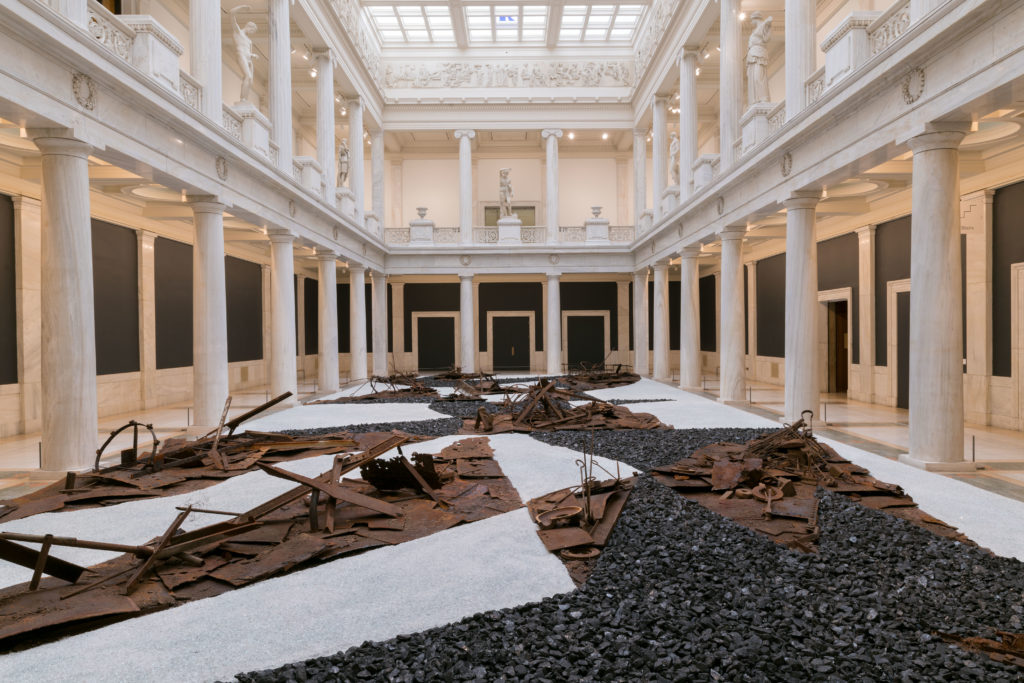
Installation view of Postcommodity’s From Smoke and Tangled Waters We Carried Fire Home, 2018. Courtesy of the artists and the Carnegie Museum of Art. Photo: Bryan Conley.
Overlooking Postcommodity’s work on the second floor is a photographic installation by Zoe Leonard. A series of simple shots depicting the Rio Grande’s roiling surface are evenly spaced along the hall’s walls. The images are stone grey and mottled like the marble background of the Carnegie’s walls around them. All taken from one spot between Ojinaga, Chihuahua, and Presidio, Texas, Leonard’s pictures are a moving reflection on the significance we ascribe to rivers—as a geopolitical border, obstacle, route.
Philadelphia-based artist Alex Da Corte takes a slightly different approach. His room-filling installation, one of the standouts, features a neon-lit house and glass floor meant to invoke the nearby stage home of a local hero, Mr. Rogers. With seats inside directed toward a series of stacked screens, the installation features 57 surreal videos from Da Corte—another nod to that magic number.
Some of these feature the artist himself dressed up as Rogers, down to the parted salt-and-pepper hair and colorful cardigans, walking through a surreal version of the show’s introduction. Others employ cartoony characters, usually with Da Corte in costume, enacting strange scenes—like live-action interpretations of Mr. Rogers’s puppet shows or a fever dream inside a Saturday morning cartoon.
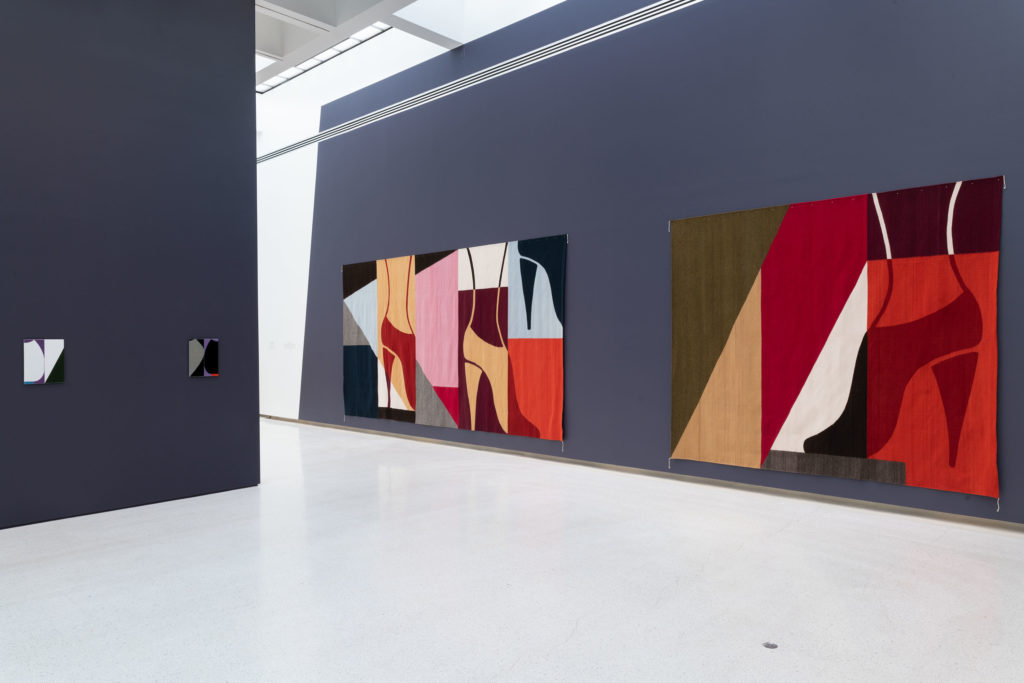
Installation view of Ulrike-Müller’s Wraps and Rugs con zapatos, 2018. Courtesy of the artist and Callicoon Fine Arts New York. Photo: Bryan-Conley.
But once more, the works that feel the most keenly in line with the show’s engagement with history also have the sharpest critical edge. An installation of 365 of Japanese artist Yuji Agematsu’s signature sculptures—cellophane cigarette wrappers filled with debris he collects on daily New York walks—stand as a moving look at the passing of time and the debris left in its wake.
Elsewhere, a photo installation by Dayanita Singh similarly looks at collection and accumulation. A series of the artist’s modular, collapsible box frames sit stacked on the gallery floor. They’re populated on each side with photos of busy archive storage units in Rajasthan and Pakistan, showing us not what is being preserved, but the conditions of the preservation itself.
Singh is less interested in the “what” of archiving than the “how” and—more importantly—the “why.” Her project asks the questions that the exhibition itself, often relying on surface-level engagements with its own lineage, wants to ask: Why do we collect what we do? Who has the power to deem something valuable, and worth saving?
The 57th Carnegie International is on view at the Carnegie Museum of Art, Pittsburgh, through March 25, 2019.
